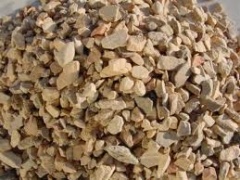Diatomite
| Infobox on Diatomite | |
|---|---|
| Example of Diatomite |  |
| Facts | |
| Origin | U.S.A., Europe, Algeria, Russia |
| Stowage factor (in m3/t) | - |
| Humidity / moisture | - |
| Ventilation | - |
| Risk factors | See text |
Diatomite
Description
Diatomite or diatomaceous earth is a soft, bulky, solid material (88% silica) composed of skeletons of small prehistoric aquatic plants related to algae (diatoms). They have intricate geometric forms. Available as light-coloured blocks, bricks, powder, etc.
Diatomaceous earth also known as diatomite or kieselgur, is a naturally occurring, soft, siliceous sedimentary rock that is easily crumbled into a fine white to off-white powder. It has a particle size ranging from less than 1 micrometre to more than 1 millimetre, but typically 10 to 200 micrometres. This powder has an abrasive feel, similar to pumice powder, and is very light, due to its high porosity. The typical chemical composition of oven dried diatomaceous earth is 80 to 90% silica, with 2 to 4% alumina (attributed mostly to clay minerals) and 0.5 to 2% Iron Oxide.
The product is insoluble in acids except hydrogen fluoride, soluble in strong alkalies. Absorbs 1,5-4 times its weight in water, also has high oil absorption capacity. Poor conductor of sound, heat and electricity.
Application
Diatomaceous earth consists of fossilized remains of diatoms, a type of hard-shelled algae. It is used as a filtration aid, mild abrasive in products including toothpaste, mechanical insecticide, absorbent for liquids, matting agent for coatings, reinforcing filler in plastics and rubber, anti-block in plastic films, porous support for chemical catalysts, cat litter, activator in blood clotting studies, and a stabilizing component of dynamite. As it is heat-resistant, it can also be used as a thermal insulator.
Shipment / Storage
In bulk or palletised in paper bags. Non combustible.
As with all powders, limit the creation and inhalation of dust. Wet floors may become extremely slippery when diatomite is present.
Risk factors
Consult the applicable MSDS sheet.











